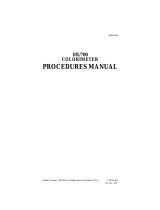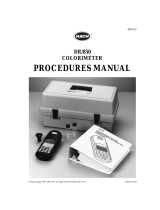Page is loading ...

EDGE Application Guide Page 1 of 2
How to Extract Fat from Food Samples that Require Acid Hydrolysis on the EDGE 2021-01
www.cem.com © 2020 CEM Corporation
All rights reserved. This may not be reproduced or published without written permission from CEM.
How to Extract Fat from Food Samples that Require Acid Hydrolysis on
the EDGE
Introduction
Fat extractions are required by food manufacturers. Often, food samples must be prehydrolyzed using acid in order to recover their total
fat during extraction. For example, foods that undergo chemical changes at temperatures lower than normal fat extractions, like eggs,
require this step. Please use this operating procedure to use acid hydrolysis to extract fat from foods that require prehydrolysis or for
customers that see this step as mandatory in their laboratory.
Sample Types
Foods with bound fat or any food a customer wants to hydrolyze. Please do not use this method for the extraction of fat from meat.
Sample Preparation
1. Mill or homogenize the food sample.
Note: Is the food wet? Please pre-dry your sample in an oven at 100 °C for 1 hour prior to milling.
2. Weigh 3 g or less of the food sample into a glass beaker. Record the weight.
Note: Use lower sample sizes (2 g or less) for fattier foods like nut butters.
3. Add 45 mL of boiling water to the sample. Then, add an addition 55 mL of 8 M HCl to the sample.
4. Stir the mixture with a glass stir rod, cover the mixture with a watch glass, and allow the sample to boil for 1 hour using a hot
plate or heat block. The mixture will turn a variation of black.
5. Remove the mixture from heat, and allow it to cool to the touch.
6. Assemble a filtration set up using a Whatman 1 filter.
Note: A filtration set up could be a filter placed in a Buchner funnel in a filter flask with an attached vacuum or a filter
placed into a funnel with a flask underneath, allowing the sample to drip through via gravity.
7. Transfer the sample into the filtration assembly, and allow the filter to collect the black hydrolysis product. Rinse the original
sample beaker with 100 mL of water to transfer any hydrolysis product that may remain in the beaker.
8. Remove the filter from the filtration set up. Oven dry the filter for 1 hour at 100 °C.
9. Prepare the Q-Cup by inserting a G0 Q-Disc into the bottom of the Q-Cup and then layering a Q-Support on top.
Note: Please select G0 as the Q-Disc in the EDGE method when programming the EDGE method.
10. Insert the dried filter into the top of the Q-Cup.
Note: The filters can be torn or perforated without decreasing fat recovery. If the filters used are large, they can be
torn to better fit inside the Q-Cup.
11. Place a Q-Screen on top of the folded filter, and compress the filter into the Q-Cup using the Q-Screen tool.
12. Place the Q-Cup in the EDGE rack. Place pre-weighed vials with weight recorded in rack.
EDGE Extraction
13. Prepare the EDGE by priming a solvent line with petroleum ether or the desired solvent and programming in the EDGE
method below.
14. Extract the sample using the EDGE method below.
Note: This method requires two 40 mL or 60 mL vials.
Cycle Solvent Top add
(mL)
Bottom add
(mL)
Rinse
(mL)
Temperature
(°C)
Hold
(mm:ss)
1 Petroleum ether 30 0 10 140 05:00
2 Petroleum ether 30 0 10 140 05:00
Wash Petroleum ether 20 - - 30 00:15

EDGE Application Guide Page 2 of 2
How to Extract Fat from Food Samples that Require Acid Hydrolysis on the EDGE 2021-01
© 2020 CEM Corporation
Post Extraction Work Up
15. Remove the extract vials from the rack.
Note: The resulting extract may have a yellow tint if the sample is higher fat content.
16. Place vials in an evaporator at 60 °C, and allow all solvent to evaporate.
Note: Fat will remain as an oily, viscous layer at the bottom of the vial.
17. Place vials in an oven for 1 hour at 100 °C to remove any residual moisture or solvent.
18. Allow vials to cool, and weigh.
Note: % Recovery = ((Vial1 after – Vial1 before)+ (Vial2 after – Vial2 before))/Sample weight x 100%
Where vial after is the weight of the vial after evaporation and vial before is the weight of the vial before extraction
Method Development Tips
• The method below is a conservative method applicable to most sample types. Please note that a more optimized method for
specific samples may be available. Please contact Molecular Support for more information.
• There are many acid hydrolysis methods available in the literature. Any method can be used, as long as the black hydrolysis
product is filtered, thoroughly rinsed with water, and caught by a filter that can be dried and extracted.
• Other extraction solvents, such as diethyl ether and hexane, can be used to extract fat.
• If recovery is lower than expected with this method, increase hold time for each cycle by 1 minute. Also, consider increasing
the total extraction volume or reducing sample size, if possible.
/



